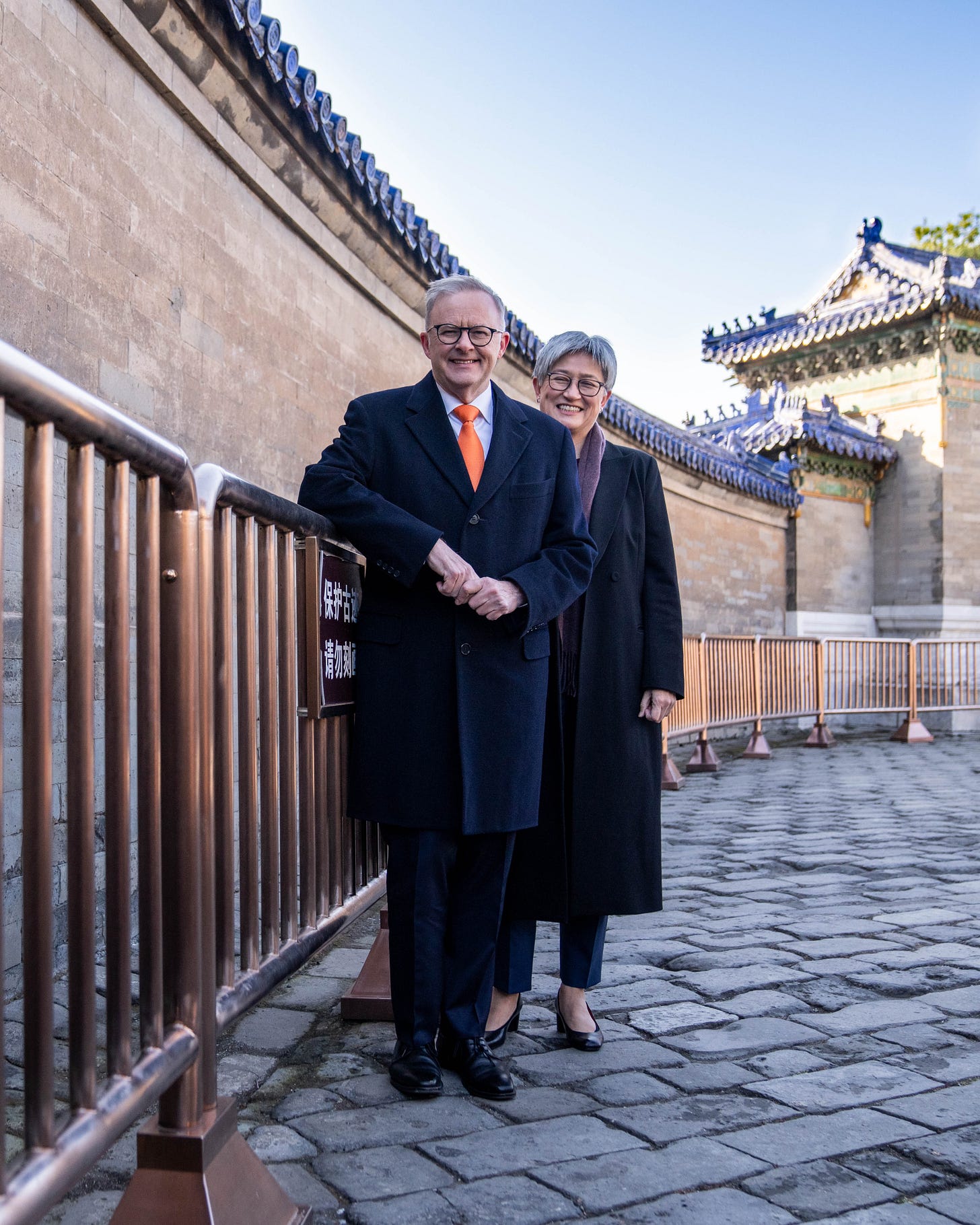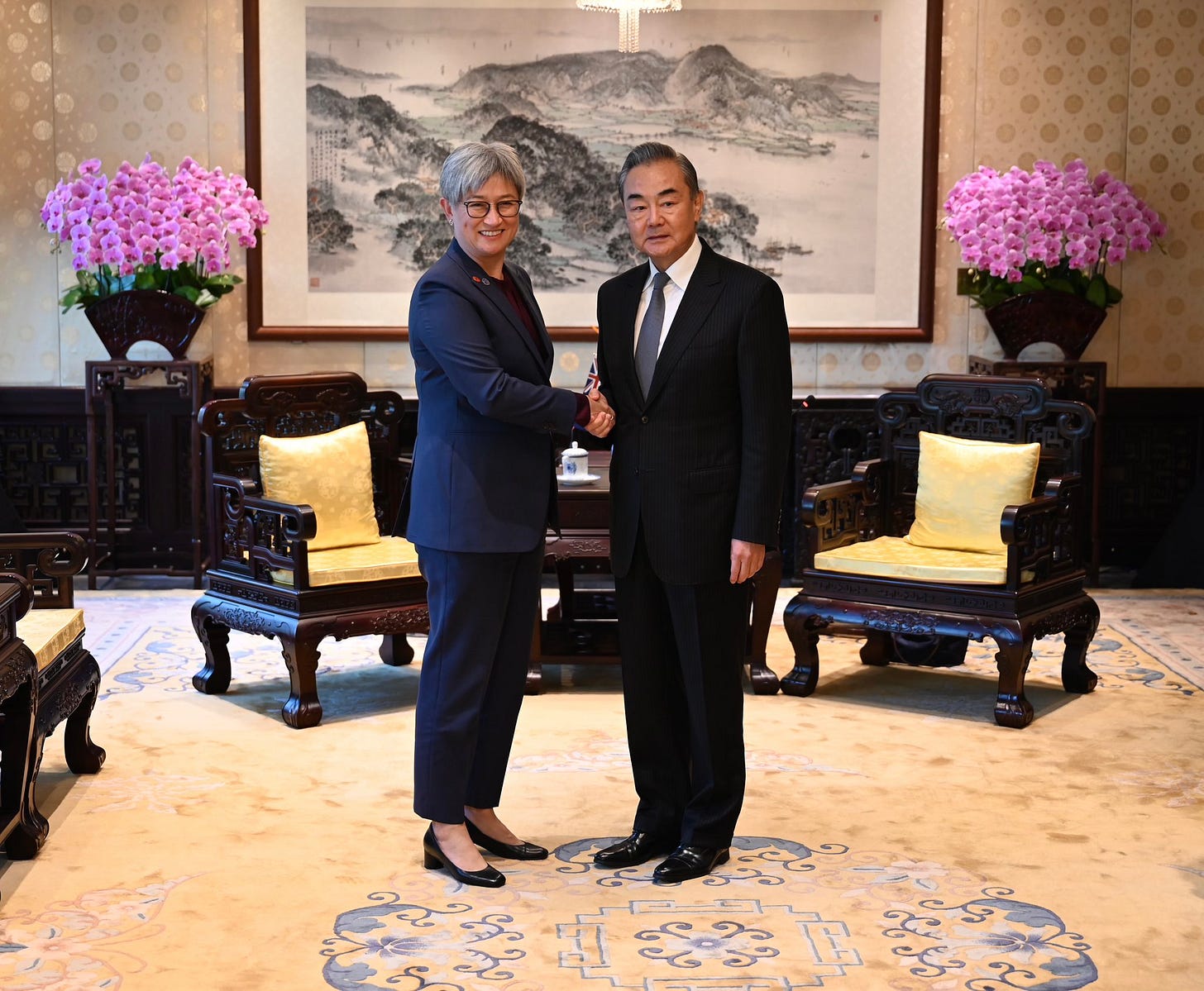The Prime Minister's visit, what really caused relationship repair, and a policy takeaway
Week(-ish) of 30 October to 7 November 2023
Mea culpa in advance for the length of what follows. As well as offering a wrap up of Australian Prime Minister Anthony Albanese’s China visit, this edition includes an extended effort to parse and assess the factors that contributed to relationship repair. I’ve also tried to unpack what, if any, the policy takeaway might be from the revival of bilateral ties.
Also, for readers in DC, let me know if you want to grab a coffee and talk Australia-China ties/Chinese statecraft/US-China competition. I’ll be in town the first half of next week for the launch of the National Bureau of Asian Research’s latest Strategic Asia volume. Drop me a line if you want to connect.
The Prime Minister’s visit
From Prime Minister Albanese’s press release on 7 November, which marked the conclusion of his visit to China:
“The Prime Minister spoke to President Xi [Jinping] and Premier Li [Qiang] about where we can cooperate on areas of mutual interest. Both sides agreed to pursue greater practical cooperation, including on trade and economic issues, agriculture, climate change and education.”
Quick take:
The visit to China by Prime Minister Albanese and his trade and foreign ministers was replete with both symbolism and practical outcomes. As predicted in BCB last edition and earlier this year, the Australian and Chinese governments each emphasised the historic significance of the visit; both in terms of the 50th anniversary of the first-ever trip to the People’s Republic of China by a serving Australian prime minister and the years elapsed since the last such visit. To put it in perspective, President Barack Obama was still in the White House the last time an Australian leader touched down in China. Also as previously forecast in BCB, Prime Minister Albanese did a China International Import Expo walk through, delivered a speech there, and took some snaps with Australian wine, lobster, and beef (the three Australian exports that are still in the crosshairs of Chinese trade restrictions).
As well as hefty doses of theatrics, symbolism, and ceremony, the visit featured a busy schedule of high-level meetings. This included formal discussions between Prime Minister Albanese and President Xi Jinping, Premier Li Qiang, and Zhao Leji, Chairman of the Standing Committee of the National People’s Congress. In effect, Prime Minister Albanese met with the 1st, 2nd, and 3rd ranked members of the 7-person Politburo Standing Committee of the Chinese Communist Party (CCP), which is probably the Party’s and by extension the country’s most powerful decision-making grouping. The schedule of calls also included meetings in the foreign affairs and trade portfolios.
There was no further concrete movement on China’s remaining trade restrictions on wine, lobster, and beef during the visit. But speaking to journalists on 6 November, Minister for Trade and Tourism Don Farrell said he expected that Australian lobster and beef would be “back into the Chinese market” in a “very short space of time.” Although invitations to visit Australia were issued to both President Xi and Premier Li, there were no firm indications if and when these trips might occur. The visit did, however, produce tangible deliverables. As floated in the last edition of BCB, the visit marked the resumption of the Annual Leaders’ Meeting, which last occurred in 2019. Other outcomes included reciprocal and long-term multi-entry visas and the recommencement of the Strategic Economic Dialogue, which was formally suspended in 2021 and last occurred in 2017.

A cornucopia of plausible accounts
Australian Minister for Foreign Affairs Penny Wong quoted in The Sydney Morning Herald on 4 November:
“We’ve [stabilised the Australia-China relationship] through calm and consistent dialogue, we’ve done so through engagement.”
Quick take:
It’s unsurprising that Prime Minister Albanese and his senior ministers present their China diplomacy as the protagonist of relationship repair (e.g., here, here, and here). It’s equally unremarkable that the opposition tells a very different story in which Canberra’s approach to engagement plays a bit part. Here’s how Shadow Minister for Home Affairs and Cyber Security James Paterson described relationship repair on 24 October: “China is reversing [its destabilising actions] for their own reasons, not because of us or anything that we do.” To some extent, the repair of the Australia-China relationship has become a Rorschach test in which assessments of why it occurred seem to be tied, among other things, to both domestic politics and how one apportions blame between Beijing and the Morrison government for the original downturn in bilateral ties.
I don’t want to wade into either domestic politics or a blame game here. And rather than one or the other of the above explanations for relationship repair, I tend to think that a more complete and accurate account needs to consider a much larger suite of factors. Although I don’t pretend for a second that it’s an exhaustive list (and I’d welcome suggested additions), at minimum the below 15 factors have (by my reading, at least) contributed to varying degrees to relationship repair. It’s no surprise that I include what the Albanese government has and hasn’t done since May 2022. But there’s a wide range of other likely contributing causal factors that shouldn’t be ignored. In what follows, I’ve (roughly and imperfectly) categorised them according to whether they’re related primarily to Australia’s actions, China’s motivations or third factors over which neither Canberra nor Beijing had complete control.
Australia’s actions
Message discipline and a willingness to describe China and bilateral developments in ways more appealing to Beijing, including using language that gave the impression of legal rigour regarding the Chinese government’s eventual release of long-detained Australian journalist Cheng Lei.
Tactical caution on the roll out of China-related policies, including deciding to scrutinise rather than veto Confucius Institutes.
Policy restraint in the form of eschewing actions that would have aggravated China, including not imposing targeted sanctions on Chinese officials implicated in severe and systematic human rights abuses.
A willingness to reach compromise agreements with China, including decisions to suspend World Trade Organization proceedings vis-à-vis barley and wine.
The careful timing of announcements to limit blowback from Beijing and generate more goodwill in the Chinese government, including pairing investment rejections with approvals and releasing in the lead up to the prime ministerial visit news that Chinese company Landbridge Group would keep its lease of Darwin Port.
China’s motivations
The recognition that the economic coercion campaign and diplomatic deep freeze were making it harder for China to achieve some of its objectives, including its bid for membership of the Comprehensive and Progressive Agreement for Trans-Pacific Partnership (CPTPP), which was a non-starter while trade sanctions were in place.
The failure of China’s economic coercion campaign and diplomatic deep freeze to force large-scale policy reversals from Australia, which likely prompted Beijing to consider alternative strategies (though, per the points above, China’s strongarm tactics might have been successful in the limited sense that they arguably contributed to the Albanese government not taking certain actions and implementing some policies differently).
Economic headwinds in China, which might have raised the domestic political costs of the economic inefficiencies of keeping billions of dollars’ worth of annual Australian exports out of the Chinese market.
The correlation between China’s punishment of Australia and Canberra’s embrace of both significantly expanded US force posture and the plan to acquire nuclear-powered submarines, which together could have led Beijing to judge that a confrontational bilateral relationship with Canberra had been inimical to China’s long-term military interests in the region.
Concerns about the effectiveness of the Biden administration’s allies- and partners-centric approach to competition with China, which might have given Beijing extra impetus to repair ties as a way of (potentially) forestalling Canberra’s deeper involvement in Washington’s adversarial economic and technology policies.
Third factors
The 2022 Australian federal election, which saw the victory of the Albanese government and the loss of power for senior figures in the Morrison government who China seemed to hold in especially low esteem.
The simple fact that despite the bipartisan continuity on signature national security and defence policies, the Albanese government was the inheritor rather than the initiator of a range of watershed China-related policies, including AUKUS, counter foreign interference measures, and bans on Chinese companies Huawei and ZTE in Australia’s 5G network.
The incremental waning of the geopolitical impact of the COVID-19 pandemic, which had positive flow on effects for Australia-China ties given that the pandemic was a potent accelerant for bilateral tensions in 2020.
The end of the Trump presidency, which had been correlated with a dramatic ratcheting up of tensions in both the US-China and Australia-China relationships.
The simple passing of time and the growing distance from the decisions and developments that originally caused the most intense bilateral turbulence.
Not only is this probably an incomplete list, but the nuances of each of these factors can’t be fully captured in this international affairs listicle. I also hasten to add that I’m not claiming that all these factors were comparably causally responsible for relationship repair. Indeed, some might have only contributed a little, while others might have loomed much larger. But my working assessment is that all these factors (and possibly others) contributed at least somewhat. To put it differently, relationship repair has been a multifactorial equation. It’s understandable that politicians would want to simplify the causes of relationship repair for pragmatic purposes. And it’s also to be expected that people like me will periodically use single-factor explanations in the seconds of media time that we’re sometimes given to explain Australia-China relations. Be that as it may, there’s a strong analytical case for considering and trying to integrate the complexity of the many likely reasons for the dramatic shifts in Australia-China relations in recent years and months.

The case for analytical and policy caution
From the Psychology of Intelligence Analysis by Richards J. Heuer:
“As a general rule, the greater your level of uncertainty, or the greater the policy impact of your conclusion, the more alternatives you may wish to consider.”
Quick take:
On top of the multiple likely contributing factors to relationship repair, there’s a further consideration that should prompt caution. Both the Australian actions and third factors listed above are (to varying degrees) not especially empirically contentious. In contrast, Beijing’s motivations are much harder to ascertain. We can certainly make plausible inferences about what China wanted by considering Beijing’s public messaging and reported decisions. But owing to the difficulties of verifying the CCP’s genuine motivations and the relatively controlled information environment in China, it’s hard to get anything approaching ground truth on what ultimately prompted President Xi and other senior decisionmakers to embark on relationship repair.
More broadly, public messaging and reported decisions are at best a rough guide to what really motivates any country. As could be true of any capital in such a scenario, it’s possible that Beijing’s embrace of relationship repair was motivated by considerations that it wouldn’t want to broadcast publicly. For example, if China was ultimately motivated by the long-term prospect of gaining Australia’s support for its CPTPP entry, then it’d make sense to not reveal these intentions for reasons of reputation and negotiating strategy. Given that Beijing probably has these and other reasons to not reveal its true motivations, we can’t confidently impute intentions simply from what China has said and done.
This uncertainty seems to lead us into a bit of an analytical cul-de-sac in which we can’t be sure what was motivating China beyond a rough standard of prima facie plausibility based on a combination of declarations and actions. That’s chastening enough. But it’s even harder to digest from a policy point of view. If we can’t assess the relative importance of the above and other possible motivations, then it quickly becomes dangerous to draw policy lessons from this episode of relationship repair. If China was primarily motivated to pursue relationship repair because it specifically wanted to stop Australia from becoming more involved in adversarial Biden administration economic and technology policies, then this episode might not be that relevant to most other countries or even Canberra’s future management of relations with Beijing. By contrast, if Beijing changed its approach to bilateral ties first and foremost because Canberra didn’t roll back the big policies that most frustrated the Chinese government, then there might be more cross-applicable lessons about the importance of holding firm in the face of pressure from China.
For what it’s worth, I’d be inclined to attribute a relatively high level of causal influence to all of the motivations mentioned above. But owing to the uncertainty surrounding these motivations and their relative importance, I’d also be reluctant to draw hard and fast policy lessons. The case for caution certainly applies to people like me who operate in the open-source and aren’t privy to internal Chinese government deliberations. But it might also apply in the classified domain. Given the hardening of the Chinese security state and the difficulties and risks of gathering reliable intelligence on high-level Chinese decision-making, it’s entirely possible that very few people beyond an inner circle in Beijing know precisely what motivated China’s embrace of relationship repair.
This is admittedly a bit of a policy anti-climax. Analytical caution about the motivations of the Chinese leadership is good and well. But it doesn’t exactly translate into a compelling policy implication. Point taken. To that end, here’s my modest policy takeaway from this episode that (I think) still stands regardless of the relatively low confidence assessments about what precisely prompted Beijing to pursue relationship repair: China’s long-term objectives were probably influential causal factors in relationship repair and Australia should be prepared for much more pressure. Beijing might have appreciated Canberra’s friendlier diplomatic language and other changes, but relationship repair was also likely intended to help China score its own policy wins.
I started writing back in February/March this year about China’s CPTPP bid and how that seemed to intersect with relationship repair. But that issue certainly isn’t the full story. So, for those who’re still following along, below is my rough working tally of what China is likely looking to get out of Australia via relationship repair. To be clear, this isn’t an exhaustive list and I make no judgement here on whether these are realistic goals. Still, following relationship repair, China seems poised to redouble its efforts to:
Wear away Australia’s opposition to China’s CPTPP entry and perhaps even convince Canberra to offer active support.
Persuade the Albanese government to adopt a more permissive approach to Chinese investments, especially in critical minerals where Canberra has twice this year explicitly knocked back Chinese or China-linked investors.
Impress upon Australia the dangers and/or lost opportunities of joining both proposed US outbound investment restrictions against Chinese technology companies and other elements of adversarial Biden administration economic and technology policies.
Keep Australia from further deepening ties with Taiwan, especially if the Democratic Progressive Party candidate William Lai wins the 2024 Taiwanese presidential election.
Further encourage Australia to exercise policy restraint vis-à-vis China’s human rights abuses, its treatment of Hong Kong, and its support for Russia, among other issues.
The Albanese government has presided over a period of rapid recovery in bilateral ties. Yet managing the Australia-China relationship could actually get even harder from here. Beijing can be expected to use a vast array of external policy tools to both cajole and browbeat Canberra into taking positions more amenable to China’s interests. Especially on specific and clearly defined issues like China’s CPTPP bid and Australia’s response to proposed US outbound investment restrictions, I’d expect Beijing to ramp up its efforts considerably. The bilateral mood might be much lighter and breezier now, but Australians should prepare for the pressure to mount as the massive machinery of Chinese statecraft gears up.

As always, thank you for reading, and please excuse any errors (typographical or otherwise). Any and all objections, criticisms, and corrections are very much appreciated.




There is no mystery about China's annoyance. The Chinese Embassy released a list of grievances that Australian media refused to publish.
Australia's attempt to destroy Huawei's global reputation – a low, cruel blow – cost Australia its biggest, most lucrative wine market.
Now Huawei's back on top and our telecoms can't even provide a reliable 4G signal.